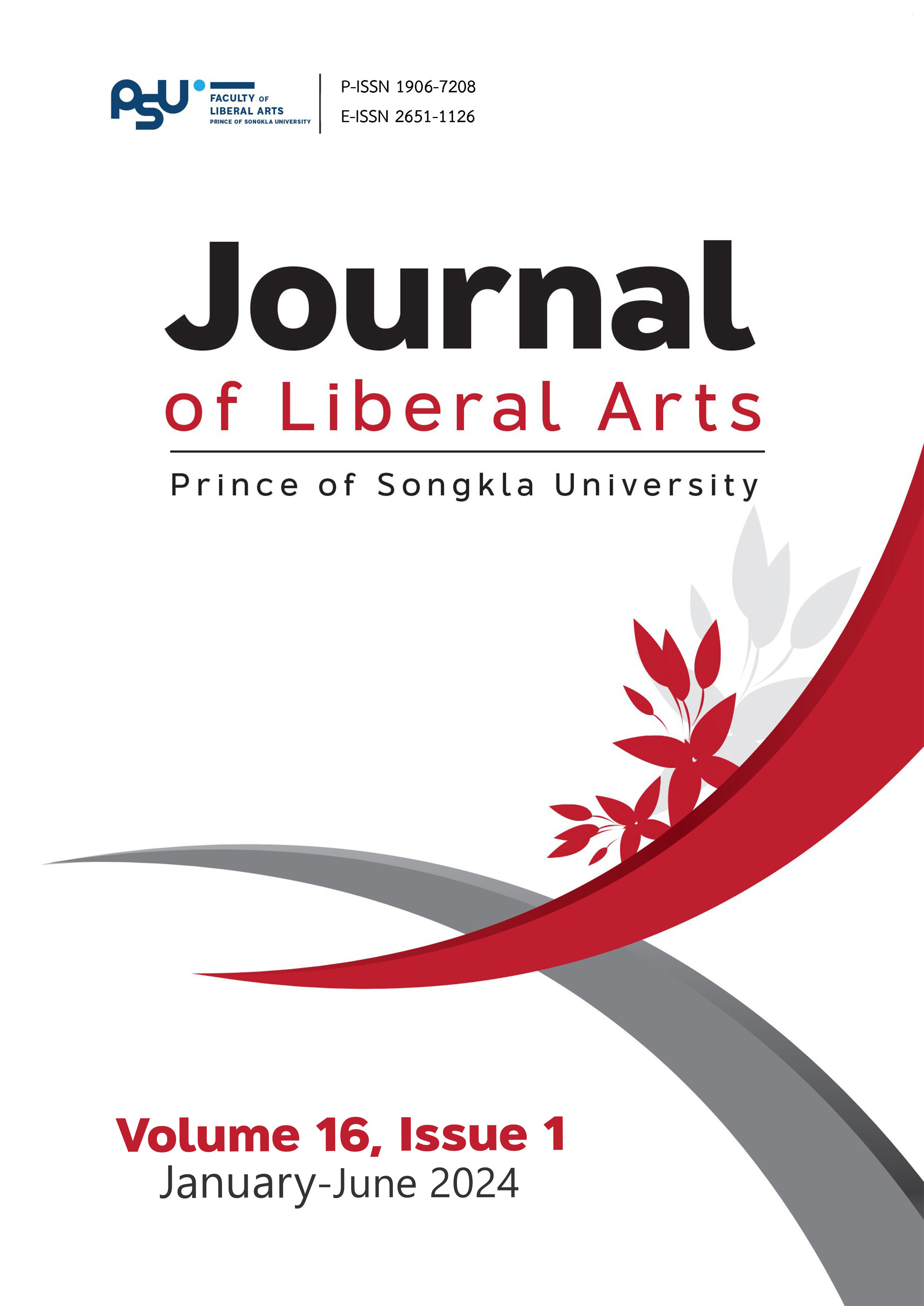การใช้กระบวนการคิดเชิงออกแบบเพื่อนวัตกรรมสังคมในการทำนุ และสืบสานอัตลักษณ์ไทเขิน บ้านต้นแหนน้อย เชียงใหม่
DOI:
https://doi.org/10.14456/jlapsu.2024.3คำสำคัญ:
กลุ่มชาติพันธุ์ไทเขิน, อัตลักษณ์, กระบวนการคิดเชิงออกแบบ, นวัตกรรมสังคมบทคัดย่อ
นวัตกรรมเพื่อสังคมเป็นแนวทางใหม่ในการระบุปัญหาและความต้องการที่ลึกซึ้ง และร่วมสร้างงสรรค์แนวคิดใหม่ๆกับสมาชิกในชุมชนในการแก้ปัญหา งานวิจัยนี้มุ่งเน้นการใช้กระบวนการคิดเชิงออกแบบเพื่อศึกษาความต้องการเชิงลึก เสนอแนวทาง ร่วมสร้างและทดสอบแบบจำลองนวัตกรรมเพื่อสังคมในการสืบสานอัตลักษณ์ไทเขิน ที่อาจจะอยู่ในรูปแบบของผลิตภัณฑ์และบริการ กระบวนการและแนวทางปฏิบัติ ตลอดจนข้อกำหนดใหม่ๆ ผู้เข้าร่วมวิจัยประกอบด้วย สมาชิกในชุมชนไทเขินบ้านต้นแหนน้อย อำเภอสันป่าตอง จังหวัดเชียงใหม่ จำนวน 15 คน และผู้ที่มีส่วนได้ส่วนเสีย จำนวน 15 คน จากการคัดเลือกแบบเจาะจงและคัดเลือกกลุ่มตัวอย่างแบบลูกโซ่ วิธีการรวบรวมข้อมูลแบ่งเป็น 3 ระยะของกระบวนการคิดเชิงออกแบบ ระยะที่ 1 เข้าใจบริบทและระบุความต้องการเชิงลึก (Empathize and Define) โดยการสังเกตการณ์และสัมภาษณ์เชิงลึก ระยะที่ 2 เสนอแนวทางและสร้างแบบนวัตกรรมสังคม (Ideate and Prototype) โดยการประชุมกลุ่มและระดมสมองเพื่อเสนอแนวทาง คัดเลือก และออกแบบรูปแบบนวัตกรรมสังคมความต้องการเชิงลึกของชุมชน และระยะที่ 3 ทดสอบเพื่อประเมินรูปแบบนวัตกรรมสังคม (Test) โดยการประชุมกลุ่มร่วมกับชุมชนเพื่อแลกเปลี่ยนความคิดเห็นและปรับปรุงนวัตกรรมสังคม ผลการวิจัยพบว่า ปัญหาหลักคือเยาวชนไม่สนใจและไม่เข้าร่วมกิจกรรมสืบทอดวัฒนธรรมไทเขินจากบรรพบุรุษ นำไปสู่ความต้องการในการสร้างโอกาสประกอบอาชีพจากอัตลักษณ์ชุมชนไทเขิน เพื่อสร้างรายได้และดึงดูดเยาวชนให้กลับมาสู่ชุมชน แนวทางสำคัญที่เสนอ ได้แก่ สร้างฐานข้อมูลและสื่อการเรียนรู้วัฒนธรรมไทเขิน โปรแกรมท่องเที่ยวเชิงวัฒนธรรม สินค้า ของที่ระลึก และกิจกรรมโซเชียลมีเดีย รวมเป็น "ศูนย์อัตลักษณ์ไทเขิน" ถือว่าเป็นรูปแบบจำลองนวัตกรรมสังคมที่ถ่ายทอดอัตลักษณ์ไทเขินและภูมิปัญญาท้องถิ่นสู่คนรุ่นใหม่ ส่งเสริมการมีส่วนร่วมและสืบทอดอัตลักษณ์ไทเขินของชุมชน ตลอดจนสร้างอาชีพและรายได้จากอัตลักษณ์ไทเขิน
References
Amornkitpinyo, P., Amornkitpinyo, P., Satityapong, N., Wongrajit, S., & Thongnuypram, C. (2022). Social innovation for quality of life. Journal of Educational Innovation and Research, 4(2), 279-286.
Boonlue, T., & Konchiab, S. (2023). Design thinking process for co-creating the conservation and inheritance guidelines of the Wisdom Reed Ceremony in Chedi Nerng Community, Sanpatong District, Chaing Mai Province. Chophayom Journal, 34(2), 250-275.
Borwornraksa, O., & Hongwiangchan, W. (2020). A comparative sound correspondence: The study of Tai Khün in Kengtung and Chiang Mai. Vannavidas, 20(1), 167–195.
Chaimuang, N. (2015). Development of community enterprise management to sustainable self-reliance. Payap University Journal, 25(1), 15–39.
Chujun, S., Bhumiratana, A., Pooseesod, K., Nunthawarasilp, P., Maneekan, P., & Chamnankit, A. (2023). Malaria prevention and control innovation based on design thinking and social marketing in malaria elimination management by local administrative organization. Disease Control Journal, 49(2), 339-352.
Council, D. (2015). The design process: What is the double diamond. The Design Council. https://www.designcouncil.org.uk/news-opinion/design-process-what-double-diamond.
Dam, R. F., & Siang, T. Y. (2020). 5 stages in the design thinking process. Interaction Design Foundation. https://www.interaction-design.org/literature/article/5-stages-in-the-design-thinking-process.
Design Council. (2017). Double diamond process. https://www.designcouncil.org.uk/our-resources/the-double-diamond/.
Fongkanta, F., Buakanok, F. S., Kreupueng, S., & Phomngam, T. (2024). Community product development for distributing to health food markets through design thinking process: A case study of Hua Suea Village Lampang. Disciplinary Journal Buriram Rajabhat University, 8(1), 49-58.
Institute of Design at Standford. (2015). An introduction to design thinking process guide. https://web.stanford.edu/~mshanks/MichaelShanks/files/509554.pdf.
Intagoon, K., & Tungcharoenchai, N. (2020). The study of community potentials for cultural tourism management: The case of Wang Thong, Wang Thong District, Phitsanulok Province. Nakhon Lampang Buddhist College’s Journal, 9(3), 53–70.
Inthaniwet, O. (2014). Musical wisdom of Tai Kheun, Tai Lue, Lahu in Bandu Municipality in Chiang Rai Province. Area Based Development Research Journal, 6(3), 107–122.
Jedeeyod, P. (2023). The design of cultural and exhibition of local museum as a Tai-Khern Community Learning Center in Baan Tonhan Noi, San Pa Tong, Chiang Mai Province. JADE Journal, 5(3), 86-98.
Khamnoy, P. (2022). Functionalism and beliefs through Tai-Khun woven fabric: Case study of Baan Ton Haen, Amphoe San Patong, Chiang Mai. HUSO Journal of Humanities and Social Sciences, 6(2), 35–51.
Koh, J. H. L., Chai, C. S., Wong, B., & Hong, H. Y.. (2015). Design thinking for education: Conceptions and applications in teaching and learning. Springer.
Kongsri, R. (2021). The changes in the identity of Muang Sam Tai Community in Baan Thi, Lamphun. The Journal of Thai Lanna Wisdom, 15(2), 1–14.
Lee, C. H. (2017). Design thinking guidebook. Royal Civil Service Commission, Royal Government of Bhutan. https://www.rcsc.gov.bt/wp-content/uploads/2017/07/dt-guide-book-master-copy.pdf.
Ministry of Culture and National Electronics and Computer Technology Center. (2011). Saranai. http://www.m-culture.in.th/album/90716/.
Namsanga, P., & Pantasri, P. (2023). Khan craftsmen: Challenges and obstacles to the process of transmitting knowledge in
Khan craftsmen family in Ban Si Kaeo, Si Kaeo Subdistrict, Mueang District, Roi Et Province. Chophayom Journal, 34(3), 1-16.
Nuchniyom, R., & Sinjindawong, S. (2023). Creating networks of social innovation for the elderly with communities as foundations:
A case study of Chedi Hak, Mueang, Ratchaburi. Ratchaphruek Journal, 21(3), 108-122.
Phunphon, T., Yongphet, P., & Nakpiba, P. (2023). Design thinking for participatory organic farming community product development. Phranakhon Rajabhat Research Journal (Humanities and Social Sciences), 8(1), 255-275.
Phuwanatwichit, T. (2018). Cultural capital development and tourism attraction management for culture village Wiang Tha Kan,
San Pa Tong District, Chiang Mai Province. Journal of Community Development and Life Quality, 5(1), 14–23.
Princess Maha Chakri Sirindhorn Anthropology Centre. (2022). Tai Khern Ethnic group in Thailand. https://ethnicity.sac.or.th/database-ethnic/175/.
Saardthia, S., Kanlap, S., Pengphit, N., & Nimnuan, N. (2024). The development of social innovation in promoting community tourism to develop the grassroots economy in Takhli Subdistrict Takhli District, Nakhon Sawan Province. Social Sciences Research and Academic Journal, 19(1), 155-170.
Sunkanaporn, W. (2017). Cultural capital of Sanpatong District study for guidelines with creative economy thinking. Veridian E-Journal, 9(3), 815-829.
Tai Khern Cultural Conservation Center (2014). Tai Khern Ethnic. https://www.banklang.go.th/activities-466.html.
Taweepworachai, E. (2021). A study of guidelines for preserving based on the beliefs and rituals of Mien Ethnic in Thailand: SWOT analysis. Humanities and Social Sciences Nakhonsawan Rajabhat University Academic Journal, 8(2), 88–104.
TEPSIE. (2014). Social innovation theory and research: A guide for researchers. A deliverable of the project: “The theoretical, empirical and policy foundations for building social innovation in Europe” (TEPSIE). European Commission.
Withell, A., & Haigh, N. (2013). Developing design thinking expertise in higher education. In Reitan, J.B., Lloyd, P., Bohemia, E., Nielsen, L.M., Digranes, I., & Lutnæs, E. (Eds.), DRS // Cumulus: Design Learning for Tomorrow: 2nd International Conference for Design Education Researchers (pp.1-13), Oslo, Norway. https://doi.org/10.21606/learnxdesign.2013.160
Downloads
เผยแพร่แล้ว
How to Cite
ฉบับ
บท
License
Copyright (c) 2024 Supornphan Konchiab, Krittika Inta

This work is licensed under a Creative Commons Attribution-NonCommercial-NoDerivatives 4.0 International License.
ลิขสิทธิ์บทความเป็นของผู้เขียน แต่วารสารศิลปศาสตร์ มหาวิทยาลัยสงขลานครินทร์ ขอสงวนสิทธิ์ในการเป็นผู้ตีพิมพ์เผยแพร่เป็นครั้งแรก




